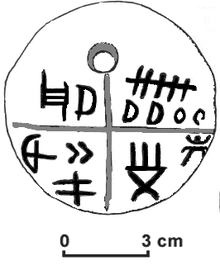Danube script
Danube script is a generic term for some regional variants of a system of signs ( Vinča sign ) of a total of over 700 characters (including all variants) from the old European period in the Danube region, which dates back to approx. 5300-3200 BC. To be dated. If it actually turns out to be script, this sign system would be the oldest known script of mankind. The finds are concentrated in Serbia , Kosovo and Romania , but inscriptions have also been found in the neighboring countries ( Bulgaria , Greece , Hungary , Ukraine ).
The Danube script as a writing system
The status of the sign system known as the Danube script is controversial. Harald Haarmann gives several positive and negative arguments for, in his controversial thesis of a Danube civilization , that these signs are writing and not just ornamental signs. He cites the type of composition of the characters, their linear arrangement and the way in which the characters are placed on objects as positive arguments for the interpretation as writing. As a negative argument against an interpretation as pure ornaments, it can be argued that the signs are not arranged symmetrically. Christa Dürscheid addresses the problem of interpreting characters as writing. She notes that it may depend on the definition of what a script is, whether that system is also understood as script or not.
Type and interpretation of the writing

The Danube script is possibly a logographic script; This means that the characters do not reproduce the sound of the linguistic elements in question, but only their meanings. The possibility of exploring their meanings varies depending on the type of characters: the so-called iconic characters (= depicting characters) can be interpreted with greater certainty than the an-iconic (non-pictorial), whereby the The repertoire of non-pictorial characters is much larger than that of the pictorial.
Danube script as a generic term
The Danube script occurs in several regional variants, which Haarmann calls the Vinča script (near Vinča southeast of Belgrade ), Trupillya script (southern Ukraine) and Turdaş script (on the Mureş river in Romania), with the Vinča script being the most important Variant is that is documented by all cultural layers of the Danube culture from the early Neolithic to the late Copper Age .
Contribution to quantitative linguistics
According to Haarmann, the V-sign of the Danube script can be identified in 29 forms, each of which is distinguished by the number of strokes that make up it. In some cases, different characters have the same complexity, making a total of 15 classes. If these are classified according to their complexity, it can be demonstrated that they comply with the law of diversification .
literature
- Christa Dürscheid : Introduction to handwriting linguistics. 3rd revised and expanded edition. Vandenhoeck & Ruprecht, Göttingen 2006, ISBN 3-525-26516-6 , p. 118. Section: “The old European writing”, p. 104–106.
- Harald Haarmann : Introduction to the Danube script . Buske, Hamburg 2010, ISBN 978-3-87548-555-4 .
Individual evidence
- ↑ Haarmann 2010, p. 23.
- ↑ Haarmann 2010, pp. 10, 73.
- ↑ Harald Haarmann : Introduction to the Danube script. Hamburg 2010, pp. 29–31.
- ↑ Christa Dürscheid : Introduction to Script Linguistics. Göttingen 2006, p. 105.
- ↑ Haarmann 2010, pp. 61, 67.
- ↑ Haarmann 2010, pp. 73f.
- ↑ Haarmann 2010, page 68.
- ^ Karl-Heinz Best : Diversification of a single sign of the Danube script. In: Glottometrics 22, 2011, pages 1-4; Test on page 2, graphic on page 3. (PDF full text )